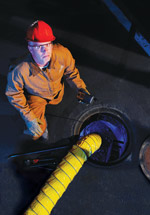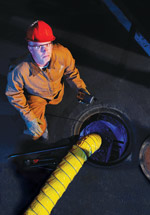
Build a Stronger Gas Detection Program
Pairing data review with analysis will improve the health of your program and keep your people safer.
- By Thomas Suski
- May 01, 2010
 If you are responsible for the health of your gas detection program, now is a great time to get it into shape. And if you want to keep your gas detection program healthy and keep your people going home safely at the end of each day, exercise your data analysis muscles by following a routine of reviewing the information stored in your gas detectors.
If you are responsible for the health of your gas detection program, now is a great time to get it into shape. And if you want to keep your gas detection program healthy and keep your people going home safely at the end of each day, exercise your data analysis muscles by following a routine of reviewing the information stored in your gas detectors.
Alarm Events
Gas detectors equipped with an event logger will record gas readings when the instrument goes into alarm. These records can include the date and time, the type of gas, and the amount of gas detected. The duration of the exposure also can be shown.
Alarm events identify any immediate or long-term threats to worker health and well-being. When looked at over time, they can provide important information about safety within a facility. This view of the data will tell you whether conditions are improving or whether you should take steps to correct a worsening situation.
Full Datalogging Capability
Gas detectors with full datalogging capability can do more. The datalogger provides a snapshot of gas concentrations in the immediate area every few seconds or every few minutes. Most of these types of gas detectors also measure short-term exposure limits (STEL) and time-weighted averages (TWA).
STEL refers to the average amount of gas in parts per million to which a worker can be exposed in a 15 minute period with no long-term health eff ects. If the STEL is exceeded, the worker must leave the area for at least one hour before returning to work, and that limit must not be exceeded more than four times in an eight-hour shift.
TWA refers to the average amount of gas to which a worker is exposed in an eight-hour shift. If the amount of gas exceeds a predetermined threshold, then the worker must not re-enter that environment for the remainder of the work day.
What the Data Can Reveal
As a safety professional, you may want to know how often high alarms happen in your facility. You may want to know which of your team members is working in these high-risk areas and what level of risk the workers face every day. If an individual is repeatedly exposed to hazardous gas, precautions should be taken to ensure his or her long-term health and safety.
Plotting alarm event data on trend graphs can provide a longer-term view. If alarm trends show an increase in hazardous gas concentrations, it may identify a worsening or more serious problem. In any case, data can provide the knowledge you need to take the next appropriate action.
Transfer and Use of the Data
Data can be downloaded to a personal computer in the same way photos are downloaded from a digital camera. From there, common office software can be used to create graphs or other visual aids for clearer analysis and presentation. However, newer technology has made on-board graphing possible through the gas detector's display. This can be helpful when assessing the onsite situation. However, these data should be combined with data from other gas detectors to give you a clearer picture of the hazards within a facility.
Helpful Technology
Most gas detection manufacturers have simplified data collection by offering docking systems that will do it automatically. Find out what, if any, data analysis tools or capabilities they offer. Most systems allow the user to export their data to spreadsheet software. Here, the data can be organized and graphed to make presentations or to identify trends in the data. This process can be helpful in reviewing data. However, manually doing this can be time-consuming if there are more than a few gas detectors in your fleet.
Current technology has presented a solution, one that indicates how the future of reviewing gas detector data may look. Right now, this technology will send data directly from a docking system to a Webbased dashboard showing trend graphs and data for equipment condition, usage, and alarms. The user even has the option of comparing the health of the company's program to industry averages.
Regardless of the system selected, data from gas detectors can alert you to potential problems. This is your starting point for gathering more information. If the problem is real, the data will help you find the root cause. If there is no problem, you can find out what affected your data. Either way, you'll be in a better position to make decisions about your safety program.
The Importance of Exposure Data
With data, you can learn know how much gas your people have been exposed to and how often. Better yet, you will have a far greater understanding of their safety if the data can be plotted and tracked on a trend graph. The idea is to somehow use the data to improve processes and keep people safer. It's not good enough to simply collect the data and store it. Unless something is done with the data, it makes little sense to collect the data in the first place.
For example, let's assume your team members are using gas detectors that work, and they're using them correctly. They leave the area after any alarm event and take the proper steps to control the hazard before continuing their work. If this is the case, then the team members are doing all they can to ensure their own safety. But what if the alarm and trend data are worsening? It could mean an underlying problem exists. These workers could be unaware of the increased risks they are now facing. Only a review of the data will alert you to this changing condition. It will give you the information needed to begin investigating and correcting the problem.
Possible Pitfalls
But reviewing data alone will not make a facility safer, and reviewing only the data stored in the gas detector may not provide the whole story. Just as physical exercise paired with proper eating habits will lead to good health, reviewing gas detector data and analyzing that data will provide a clearer picture of the health of a gas detection program.
For example, you can look at alarms caused by elevated levels of carbon monoxide. In a perfect world, you wouldn't want workers to experience any of these alarms. On the other hand, if the facility is a steel mill, the number of alarms may be in line with industry averages. This is where having an industry benchmark is really helpful. Comparing that steelmaker with others using similar processes provides another piece of information that can be used to measure the safety of a facility.
Making a Complete Picture
When you pair data review with analysis, you get a much clearer picture of what's happening in the field. Data stored in gas detectors can provide clues to what's going on. The point is to use those data to further explore any possible problem. If the data points to a problem, further investigation will determine whether or not an actual problem exists. If it does, the next step is to decide on a course of action that will strengthen your gas detection program and make the facility a safer place to work.
This article originally appeared in the May 2010 issue of Occupational Health & Safety.